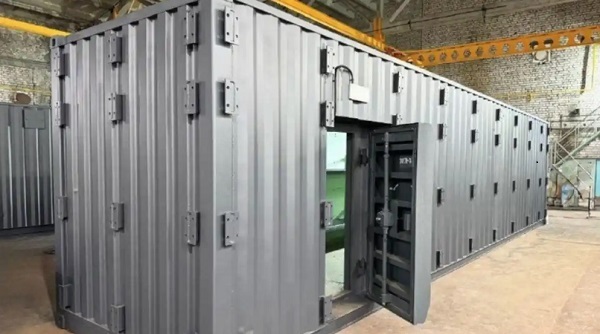Opinion
Portland is installing turbines in water pipes to produce electricity, will Red Deer consider following suit?

Portland is installing turbines in their water pipes to generate electricity. Available for 24 inch or 42 inch pipes, excellent for gravity fed water supply.
This got me thinking about our city applications. Would it be worthwhile for someone at city hall to look into possible applications for Red Deer?
If Red Deer had a guaranteed year round source of flowing water, should we harness it for Hydroelectricity? What if we had a flow rate that was only strong enough to power city buildings? Should we investigate it? If we knew parts of the equation could we not ask?
City Councillor Buck Buchanan thinks it should be looked into. Why?
The city has a guaranteed source that has been recently upgraded to 72,500 cubic meters per day. The source is our Wastewater Treatment Plant. It pumps treated water into the Red Deer River year round and it is not going to stop anytime soon.
The raw wastewater goes through different cycles and/or processes before it is released as clean water. Treated wastewater leaves the plant area through a channel before being released into the Red Deer River.
The upgraded capacity of Red Deer’s wastewater treatment plant is 72,500 cubic meters of water per day or 2.6 million cubic feet per day.
The energy in these moving waters is being wasted. Why not harness it as Hydroelectricity.
Hydroelectricity is electricity produced by movement of water. It is usually made with dams that block a river to make a reservoir or collect water that is pumped there. When the water is released, the pressure behind the dam forces the water down pipes that lead to a turbine. Our wastewater treatment plant acts like a dam as it holds back water for treatment.
So just how do we get electricity from water? Actually, hydroelectric and coal-fired power plants produce electricity in a similar way. In both cases a power source is used to turn a propeller-like piece called a turbine, which then turns a metal shaft in an electric generator, which is the motor that produces electricity. A coal-fired power plant uses steam to turn the turbine blades; whereas a hydroelectric plant uses moving water to turn the turbine. The results are the same.
People have been using the power of moving water to run water wheels and mills for more than 2,000 years. Modern power plants today convert that mechanical energy into electricity.
Tides, ocean currents, waterfalls, rivers… Moving water is a constant source of energy ready to be harnessed. Hydroelectric energy is obtained by using a turbine to convert the kinetic energy of a river or waterfall into mechanical energy, and then an alternator to transform it into electrical energy.
There are two main kinds of hydroelectric generating stations: reservoir, and
run-of-river (ROR).
A generating station with reservoir uses a dam to create an artificial lake. A run-of-river generating station has no reservoir but offers the advantage of producing electricity without having to store the water.
Hydro power plants produce minimal greenhouse gases and are a source of clean, non-polluting energy. The evaporation/condensation cycle also makes hydro energy renewable. The above qualities pertain particularly to ROR plants, which produce energy from the natural water flow, which means that the impact on the landscape, ecosystem and neighbouring communities is considerably reduced. It also costs much less to produce electricity at an ROR plant.
Such properties make ROR hydroelectricity a sensible choice, for economic, social and environmental reasons.
Run-of-river generating stations are not very complicated. Flowing water is channelled through the intake and enters a penstock, which causes it to flow with greater speed and force to the turbine. The turbine is activated by the force of the water, and it, in turn, runs the alternator to produce electricity. The water then flows down the tailrace and returns to the river.
The viability of a site and the electricity it can produce are determined by two factors: drop height and water flow volume.
Hydroelectric energy has been in use for thousands of years. Ancient Romans built turbines, which are wheels turned by flowing water. Roman turbines were not used for electricity, but for grinding grains to make flour and breads.
Water mills provide another source of hydroelectric energy. Water mills, which were common until the Industrial Revolution, are large wheels usually located on the banks of moderately flowing rivers. Water mills generate energy that powers such diverse activities as grinding grain, cutting lumber, or creating hot fires to create steel.
Hydroelectric power is also very efficient and inexpensive. “Modern hydro turbines can convert as much as 90% of the available energy into electricity. The best fossil fuel plants are only about 50% efficient. In the US , hydropower is produced for an average of 0.7 cents per kilowatt-hour (kWh).
Since we know we have a flow rate of 72,500 cubic meters per day, could we not ask an expert if we could harness it for hydroelectricity? If so how much could we produce and how much would it cost?
Just asking.
Brownstone Institute
First Amendment Blues

From the Brownstone Institute
By
You might think these are quite rare but not a bit of it; 13,200 of these were recorded in the last 12 months, and that’s around 36 a day, and they go on your record and sometimes mean you end up with no job. They also have new laws planned to control misinformation and disinformation, something not just confined to the UK. Similar laws are planned for Ireland, Australia, Canada, and the EU.
I’m envious. The US has something the UK doesn’t have, namely a First Amendment. Yes I know there are those who wish the US didn’t have it either, including, I understand, John Kerry and that woman who still thinks she beat Trump the first time around. Kerry kind of wishes that the First Amendment wasn’t quite so obstructive to his plans. But from where I stand, you should be thankful for it.
Not only does the UK not have a First Amendment, it doesn’t have a constitution either, and that makes for worrying times right now. Free speech has little currency with Gen Z and the way it looks, even less with the new UK Labour government. Even Elon Musk, who takes a surprising interest in our little country, has recently declared the UK a police state.
It’s not surprising. Take for instance the case of Alison Pearson, who had the police knocking on her door this Remembrance Sunday. They had come to warn her they were investigating a tweet she had posted a whole year ago which someone had complained about. They were investigating whether it constituted a Non-Crime Hate Incident or NCHI. Yes, you heard me right, a ‘non-crime’ hate incident and no, this is not something out of Orwell, it’s straight out of the College of Policing’s playbook.
If you haven’t heard of them, you can thank your First Amendment. In the UK you can get a police record for something you posted on X that someone else didn’t like and you haven’t even committed a crime. NCHIs are a way they have of getting around the law in the same way John Kerry would like to get around the First Amendment, except it’s real where I live.
Alison Pearson is a reporter for the Daily Telegraph, but that doesn’t mean she can write what she likes. When she asked the police what the tweet was which was objected to, she was told they couldn’t tell her that. When she asked who the complainant was, they said they couldn’t tell her that either. They added, that she shouldn’t call them a complainant, they were officially the victim. That’s what due process is like when you don’t have a First Amendment or a constitution. Victims of NCHI in the UK are decided without a trial or a defense. They asked, very politely, if Pearson would like to come voluntarily to the police station for a friendly interview. If she didn’t want to come voluntarily, they would put her on a wanted list and she would eventually be arrested. Nice choice.
It’s true that there has been a public ruckus over this particular case, but the police are unapologetic and have doubled down. Stung into action by unwanted publicity, they are now saying they have raised the matter from an NCHI to an actual crime investigation. Which means they think she can be arrested and put in prison for expressing her opinion on X. And of course they are right. In the UK that’s where we are right now. Pearson tried to point out the irony of two police officers turning up on her door to complain about her free speech on Remembrance Day of all days, when we recall the thousands who died to keep this a free country, but irony is lost on those who have no memory of what totalitarianism means.
The way things are looking I would say things can only get worse. The new Labour government has made it clear that it wants to beef up the reporting of NCHIs and make them an effective tool for clamping down on hurtful speech. You might think these are quite rare but not a bit of it; 13,200 of these were recorded in the last 12 months, and that’s around 36 a day, and they go on your record and sometimes mean you end up with no job. They also have new laws planned to control misinformation and disinformation, something not just confined to the UK. Similar laws are planned for Ireland, Australia, Canada, and the EU. Germany in particular is keen to remove all misinformation from the internet, I understand.
Whenever I see the word ‘misinformation’ these days I automatically translate it in my head to what it really means, which is ‘dissent.’ Western countries, former champions of free speech, the bedrock of liberty and individual choice, en masse it seems, now want to outlaw dissent. What is coordinating this attack on free expression, I don’t know, but it’s real and it’s upon us. We are slowly being intellectually suffocated into not expressing any opinion that others might find objectionable or that might contradict what the government said. If you had told me that would happen in my lifetime, I would have called you a liar.
I live in the UK, the home of the Bill of Rights and the Magna Carta, and the mother of parliamentary democracy. I was proud that we produced men like John Milton, John Stuart Mill, and Thomas Paine, that we understood the importance of the Areopagitica, the Rights of Man, and incorporated On Liberty into our social thinking. But those days seem long gone when police knock on your door to arrest you for an X post.
So I’m glad someone somewhere has a First Amendment even if we don’t. It may be your last defense in that republic of yours, if you can keep it.
Business
Trudeau’s new tax package gets almost everything wrong

From the Fraser Institute
Recently, Prime Minister Justin Trudeau announced several short-term initiatives related to tax policy. Most notably, the package includes a two-month GST holiday on certain items and a one-time $250 cheque that will be sent to all Canadians with incomes under $150,000.
Unfortunately, the Trudeau government’s package is a grab bag of bad ideas that will not do anything to get Canada out of the long-term growth rut in which our economy is mired. There are too many to list all in one place, but here are four of the biggest problems with Prime Minister Trudeau’s tax plan.
- It reduces the wrong taxes. When it comes to economic growth, not all taxes are created equal. Some cause far more economic harm per dollar of government revenue raised than others. The government’s package creates a holiday on the GST for some items (only for two months) which is a mistake given that the GST is one of the least economically harmful components of the tax mix. Canada’s recent growth record is abysmal, and boosting growth should be a primary goal of any changes to tax policy. A GST cut of any duration fails this test relative to other tax cuts.
- Temporary tax holidays shift consumption in time, they don’t boost growth. The government’s GST reduction is actually a short-term tax holiday on certain items that will last two months. There are decades worth of economic research showing that when governments create short-term tax breaks, they may change the timing of consumption, but they won’t contribute to actual economic growth. Shifting consumption from the future to the present won’t help get Canada out of the economic doldrums. This is particularly true of the Trudeau tax holiday since purchases that Canadians may have made after the two-month holiday period will simply be shifted forward to take advantage of the absence of the GST. As noted above, there are better taxes to cut than the GST, but no matter what taxes we are talking about permanent reductions are vastly superior to temporary tax cuts like short-term holidays.
- One-time tax rebates don’t improve economic incentives. Perhaps the worst element of the Trudeau government’s announcement was a plan to send $250 cheques to all Canadians earning under $150,000. One-time tax rebates are a terrible way to provide tax relief. When you cut income tax rates, you improve incentives for people to work and invest because they get to keep a larger share of their earnings. This helps the economy grow. One-time rebates that you get regardless of the economic choices you make has no similar effect. This means that the rebate with its $4.7 billion price tag won’t help Canada’s poor growth performance.
- It borrows from the future to give to the present. The federal government is currently running a large deficit. This raises the question of who will have to pay the $4.7 billion bill for the one-time payments announced today. The answer is that the government will have to borrow the money and therefore future taxpayers will have to either pay it off or service the extra debt indefinitely. The money the Trudeau government will send out won’t come out of thin air, it’ll have to be borrowed with the burden falling on future taxpayers.
The Trudeau government got one thing conceptually right, which is that there are advantages to reducing the tax burden on Canadians. Unfortunately, the policy package it has put forward to provide tax relief gets everything wrong. It reduces the wrong taxes, shifts taxes temporally rather than cutting them, does nothing to improve economic incentives, and burdens future taxpayers. With the holiday season around the corner, this attempt at a gift to Canadian taxpayers is the economic equivalent of a lump of coal in the stocking.
Authors:
-

 Aristotle Foundation2 days ago
Aristotle Foundation2 days agoToronto cancels history, again: The irony and injustice of renaming Yonge-Dundas Square to Sankofa Square
-

 conflict2 days ago
conflict2 days agoUS and UK authorize missile strikes into Russia, but are we really in danger of World War III?
-

 Business1 day ago
Business1 day agoCBC’s business model is trapped in a very dark place
-

 armed forces1 day ago
armed forces1 day agoJudge dismisses Canadian military personnel’s lawsuit against COVID shot mandate
-

 Alberta19 hours ago
Alberta19 hours agoAlberta fiscal update: second quarter is outstanding, challenges ahead
-

 Energy1 day ago
Energy1 day agoWhat does a Trump presidency means for Canadian energy?
-

 International1 day ago
International1 day agoElon Musk, Vivek Ramaswamy Outline Sweeping Plan to Cut Federal Regulations And Staffing
-

 conflict2 days ago
conflict2 days agoPutin Launches Mass-Production of Nuclear Shelters for his People







